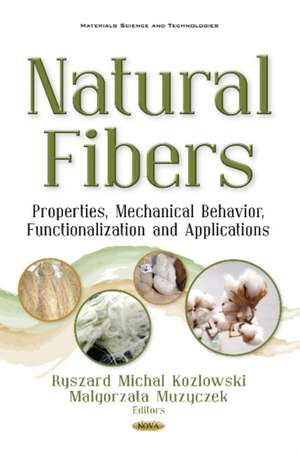Natural Fibers: Properties, Mechanical Behavior, Functionalization & Applications
Editat de Ryszard Michal Kozlowski, Malgorzata Muzyczeken Limba Engleză Hardback – 31 aug 2017
Preț: 1189.16 lei
Preț vechi: 1382.73 lei
-14% Nou
Puncte Express: 1784
Preț estimativ în valută:
227.56€ • 235.11$ • 189.30£
227.56€ • 235.11$ • 189.30£
Carte indisponibilă temporar
Doresc să fiu notificat când acest titlu va fi disponibil:
Se trimite...
Preluare comenzi: 021 569.72.76
Specificații
ISBN-13: 9781536120714
ISBN-10: 1536120715
Pagini: 300
Dimensiuni: 155 x 230 x 27 mm
Greutate: 0.87 kg
Editura: Nova Science Publishers Inc
Colecția Nova Science Publishers Inc
ISBN-10: 1536120715
Pagini: 300
Dimensiuni: 155 x 230 x 27 mm
Greutate: 0.87 kg
Editura: Nova Science Publishers Inc
Colecția Nova Science Publishers Inc
Cuprins
Introduction; Cotton Dominant Natural Fibre: Production, Properties & Limitations in Its Production; A New Challenge For Flax & Hemp Bast Fibers; Breeding & Cultivation of Flax in China; Curaua Fibers: The Queen of the Fibers; Ethnobotany & Natural Fibers in Brazil: Preliminary Studies of Daphnopsis Fasciculata for Textile Applications; New Emerging Sources of Other Lignocellulosic Fibers; Natural Lignocellulosic Raw Material as a Source of Nanocellulosic Fibres; Alpaca Fiber: Production, Characteristics & Use; Bioengineering as a Driving Force in Natural Fibres Stabilization & Production Growth; The Role of Apparels Based on Natural Fibres in Human Physiology & Healthy Being; Trends in Natural Lignocellulosic Fiber Functionalization & Finishing Processes; Functionalization of Natural Fibers by Dendritic Polymers; Bio-Based Composites; Poly(ε-Caprolactone)/Poly(Lactic Acid)/Oil Palm Fiber Composites: Properties, Mechanical Behavior & Applications; Plant Fibers: Renewable Reinforcing Filler in Polyolefin Bio-Composites; The Use of Palm Fibers Reinforced in Polymer Matrices for Various Applications; Source of Further Information about Natural Fibers; Index.
